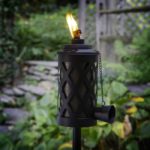A healthy lawn has a number of benefits: It absorbs noise and rainfall, purifies water, generates oxygen, and even captures pollutants. However, lawn maintenance is essential if you really want to reap those benefits. Without proper care, your lawn will easily fall victim to different diseases and lose its beauty.
A lawn typically needs 1-1.5 inches of water per week, which can be spread over one or two watering sessions. Established lawns need deeper watering (1-2 times a week), but with newly seeded lawns, you need to keep the top inch moist with a gentle spray a couple of times a week.
One important part of caring for your lawn is giving it the correct amount of water. Let’s take a closer look at how often you should water your lawn and how you can determine if you’re giving enough water. We’ll also look at how different types of sprinklers affect watering.
How Often Should You Water Your Lawn?

Overwatering or under-watering your lawn can easily kill the grass. Typically, you need to give your lawn 1-1.5 inches of water per week, but that varies depending on the type of grass you’re growing, your lawn’s age, the type of soil, and the climate where you live.
If you have an established lawn, you need to keep the top 6-8 inches of the ground moist (not soggy). You should have infrequent but deep watering sessions to encourage drought resistance and strengthen the roots.
This means you should water your lawn two times a week almost throughout the year, but increase the frequency to three times a week in the summer months. Be careful not to overwater it, though.
In the case of newly seeded lawns, you need to ensure that the top inch of the soil has enough moisture but is not soggy. So instead of watering a couple of times a week, you’ll have to use a mister like this one by Newbeer (on Amazon) and spray the area 1-2 times a day — or more if it’s dry and hot outside.
When the seeds start to germinate, your goal should be to keep the top couple of inches of the soil moist. Then, once the grass is at mowing height (about 3 inches), you can cut down watering to two times a week.
Eventually, you should provide enough water to soak the soil all the way down to 6-8 inches as the lawn becomes well-established.
What Time of Day Is Best for Watering?
The ideal time to water the lawn is before 10 am. Between 4 and 6 am is best, since that’s when it’s cool, the winds are calm, and the moisture is less likely to evaporate even before your grassroots have the chance to absorb it.
However, if it’s impossible to water the lawn before 10 am, the next best time is between 4 and 6 pm, so that the grass blades have enough time to dry before it gets dark.
Never water the lawn late at night since the moisture will sit on the grass overnight and make the lawn more disease-prone.
How to Determine if You’re Watering Enough
There are a number of things you can do to determine if you’re giving enough water to your plants.
When watering the lawn for the first time, use a screwdriver and test the soil every 15 minutes to check how deep the water has gone. Take note of the time it takes for the water to go down to 6 inches.
This is the time period for which you’ll need to water the lawn each time. If the screwdriver is difficult to stick 6 inches deep in the soil, that means your lawn needs watering!
If you have a sprinkler system (on Amazon), you can just use the flow rate provided by the manufacturer to determine how long you should run the sprinkler system. Simply multiply 0.62 gallons by your lawn’s square footage and divide the result by the flow rate of the sprinkler.
You can also place empty tuna cans around your lawn and note the time it takes for 1-1.5 inches of water to collect in one can. But keep in mind that since the patterns for sprinkler coverage vary throughout your lawn, you’ll need to take out the average time it takes for all the cans to fill up and use that.
Another thing you can try is using a flow timer (on Amazon) that measures the flow of water in hundreds of gallons. Now all you have to do is multiply the square footage of the lawn by 0.62 gallons and you’ll get the total gallons you need to water the whole lawn.
Signs You’re Not Watering Enough
There are a number of signs you can keep an eye out for to know if your lawn needs water.
Perhaps it goes without saying, but if your lawn starts turning gray, that’s a clear sign that it needs water. Another indicator of lack of water is curled glass blades.
In addition to the screwdriver test mentioned above, there’s another very simple test to check the water situation. All you need to do is just walk on the lawn. If the lawn is watered well enough, the grass should immediately spring back up on the area you’ve stepped. If it fails to do so, it means it lacks moisture and needs water.
Cool-Season vs. Warm-Season Grass Types
Both cool-season and warm-season grasses need to be cared for in different ways so that they stay healthy and hardy.
Cool-season grasses like Kentucky bluegrass, fine fescue, and perennial ryegrass grow during the fall and need roughly 1-1.5 inches of water per week until the end of the growing season. Tall fescue is the most drought-tolerant type of cool-season grass because of its deep root system.
Keep in mind that if you don’t give water to these cool-season grasses in a drought, they’ll become dormant — but they’ll turn green again once it starts to rain.
Meanwhile, warm-season grasses like centipede grass, zoysia, St. Augustine, and Bermuda mostly grow in the summers and can better withstand droughts thanks to their deep root systems. While they require comparatively less water as compared to cool-season grasses, you still need to give them extra water when it’s too hot.
How frequently you should water the grass depends on a few things, like your location (the rainfall and the weather conditions in the summer) and the type of soil.
Grass needs a good amount of water in low humidity, heat, high winds, and drought. Plus, clay soil retains water better and doesn’t need to be watered frequently, while sandy soil drains quickly and should be watered more frequently.
How Different Sprinklers Types Affect Watering

You can water your lawn in a number of different ways, from smart watering systems to sprinklers. Each type of sprinkler comes with its benefits, so you should choose the solution most suitable for your lawn. Here are the most common options available:
Water Guzzlers or Pulsating Sprinklers
Pulsating sprinklers (on Amazon) shoot a powerful stream of water horizontally at a very high speed, allowing them to cover a large lawn easily without being affected by the wind. With such sprinklers, grassroots get the moisture they require quickly.
However, they aren’t the most suitable option for sodded or newly seeded lawns, especially because of their high intensity.
Hose-End Sprinklers
Hose-end sprinklers (on Amazon) are your traditional sprinklers and are ideal for small to medium-sized areas. They’re available in a number of different types, so you can choose one that best fits your lawn.
Oscillating Sprinklers
Oscillating sprinklers (on Amazon) are the ideal option for newly seeded lawns, especially since they don’t deliver the water with a high force like water guzzlers, but they still provide good coverage.
In-Ground Sprinklers
While in-ground sprinklers (on Amazon) can be quite expensive, they’re super efficient. The head of the sprinkler pops up automatically to water the lawn and goes back down once it’s done.
As a result, it delivers a precise amount of water. For the best results, we recommend choosing sprinklers that fit as close to the ground and opt for a horizontal spray pattern.
Smart Watering Systems
You can find a number of smart watering systems available today. In fact, most of them can easily integrate with your in-ground sprinkler systems. Most smart watering systems also come with controllers, allowing you to schedule your watering sessions right from your phone.
Some smart sprinklers, like the Rachio 3 (on Amazon), also use real-time weather data and automate watering sessions, so you don’t have to worry about it.


![How Often Do You Need To Water Sage? [+ Growing Tips] How Often Do You Need To Water Sage? [+ Growing Tips]](https://yourdiybackyard.com/wp-content/uploads/2022/09/Fresh-herbal-sage-in-a-plant-pot-in-the-garden-150x150.jpg)





